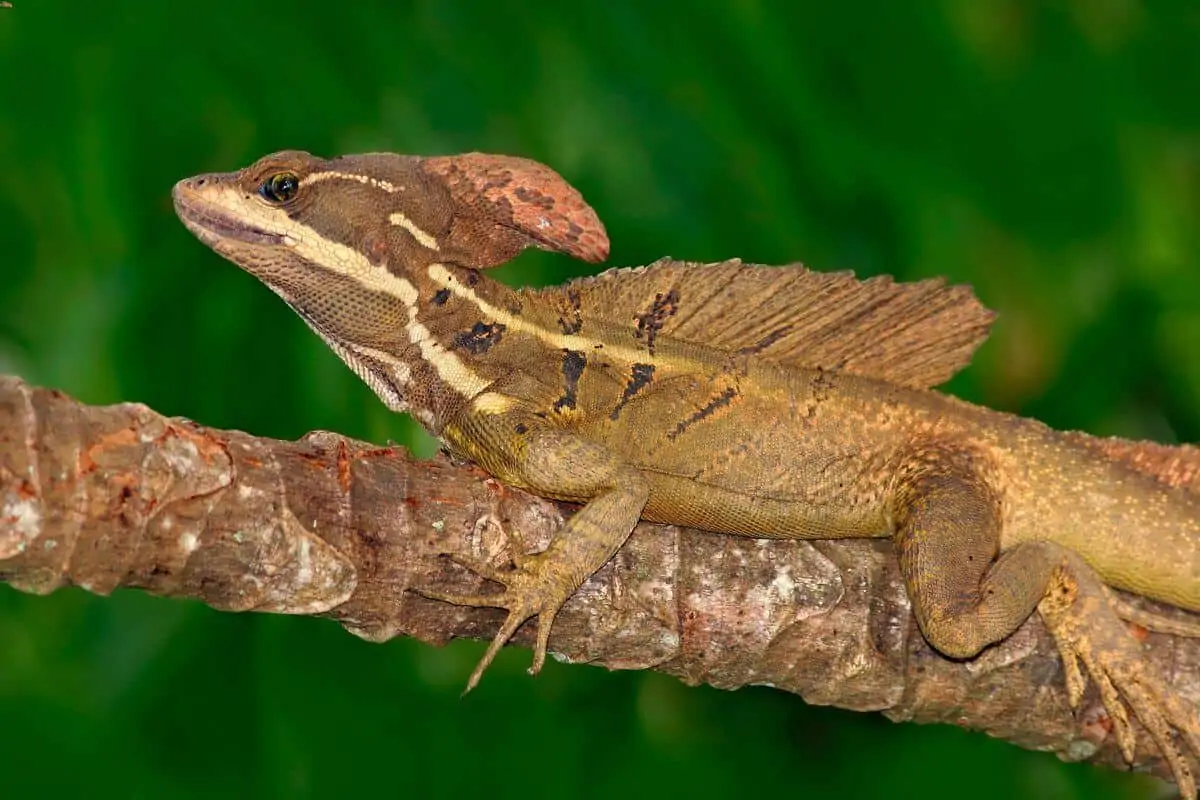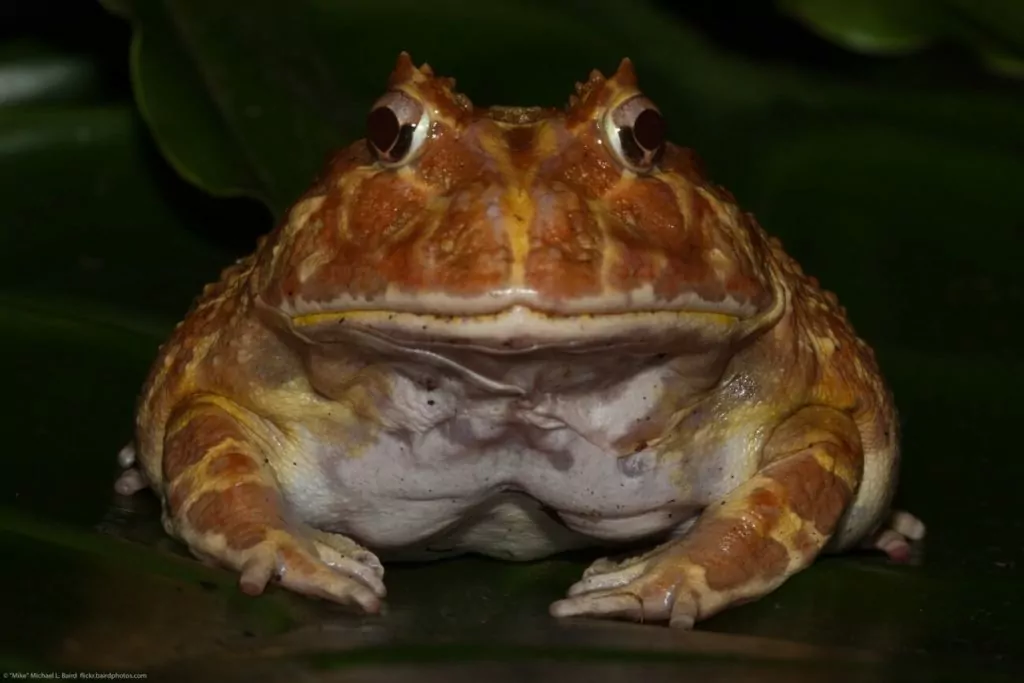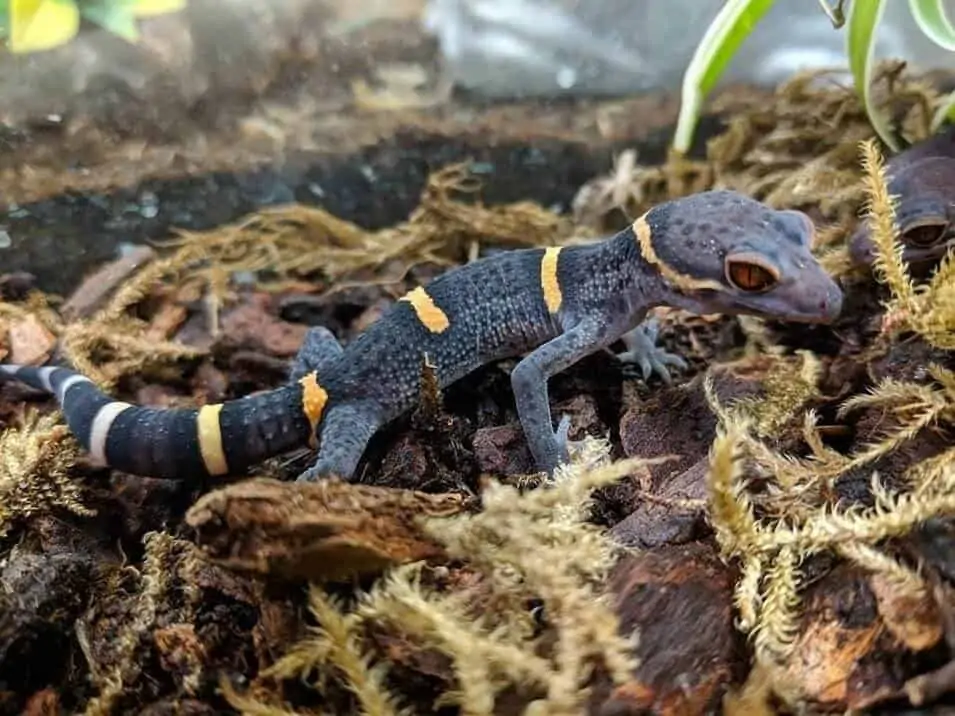Brown basilisks are beautiful lizards that can make great pets for the right kind of owner. Their interesting appearance and high activity level can provide endless entertainment!
However, you need to understand the temperament of this reptile if you want to own one. This species is easily scared, so it’s important to provide them with a habitat where they feel comfortable.
This guide covers the essentials of brown basilisk care, plus other useful facts that will make your job easy!
Table of Contents
Species Summary
The brown basilisk (Basiliscus vittatus) is a flighty lizard with a distinct appearance. Known for its dramatic dorsal crests and unique coloration, this reptile is quite eye-catching.
Originally, these lizards come from Mexico and Central America. They thrive on the edges of tropical forests and typically live close to water. In places like Guatemala, they are very widespread. Some feral populations have even started popping up in Florida!
While not as common as many types of iguanas or other lizard species, brown basilisks are still a favorite in the herpetology community. They can take a while to get comfortable. But once they get to that point, these pet lizards do very well in captivity.
Appearance & Colors
The brown basilisk is a gorgeous reptile with a handful of standout features!
The most notable are the three dorsal crests. One crest is on the top of the head. It’s not hard or rigid like the crests on other lizards. Instead, it’s supported by flexible cartilage and can flap down when the basilisk is relaxed.
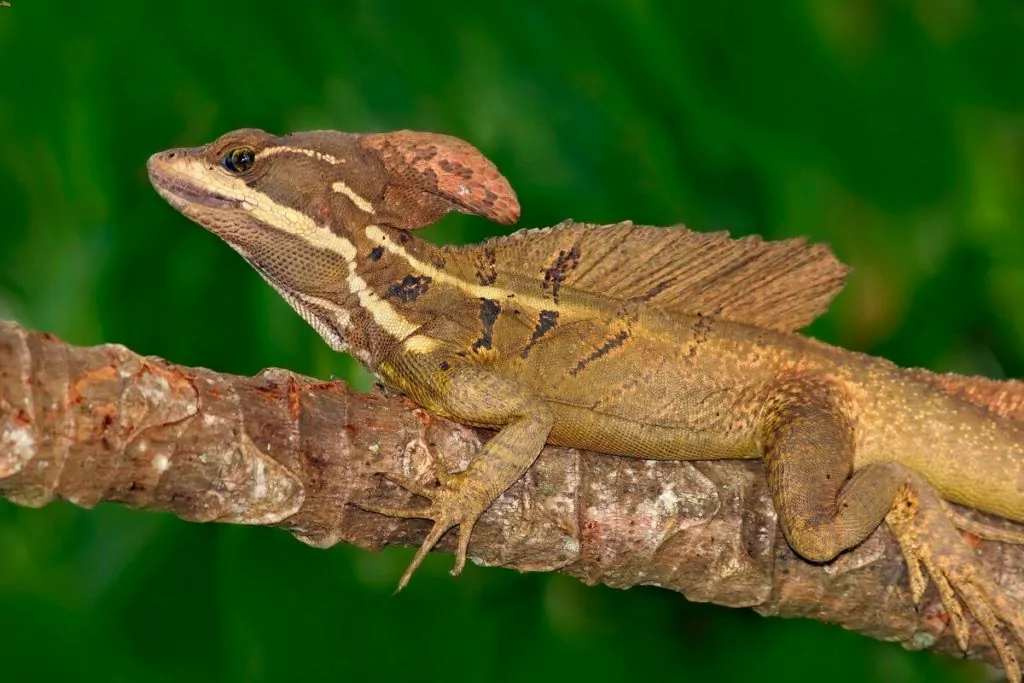
The second crest extends from the above the shoulder down to the hind legs. It, too, is flexible and can move based on the lizard’s move.
Finally, there’s the tail crest. This crest accents the laterally compressed tail and can vary in size from lizard to lizard.
The body of the brown basilisk is covered in light brown or olive green. You might see some subtle black banding on the back dorsal crest. White or light green stripes are visible, too!
They typically extend from behind the eyes to the rear legs. On some lizards, additional patches of white can appear around the mouth as well.
The feet feature long and slender toes. One cool thing about the feet is the hydrophobic scales on the bottom of the feet. Pair that with the flaps of skin between each toe, and this lizard can run impressive distances on the surface of the water!
Lifespan
The typical brown basilisk lifespan is about seven to eight years on average. Interestingly enough, these lizards usually have a longer lifespan in captivity than they do in the wild.
Expert Tip: Some can live up to 12 years, though those instances are rare.
Like any other pet, brown basilisks need high-quality husbandry to live long lives. In poor living conditions, these creatures can suffer from a litany of diseases that shorten their lifespan.
Average Size
The average size of a brown basilisk is 24 inches in length for adult males, with females being several inches smaller. This full size measurement includes the tail of these lizards, not just the body.
Something that many new owners don’t realize is that the tail takes up about two-thirds of their body. This means the upper body and head are considerably smaller by comparison, and makes these reptiles much more reasonably-sized than you might assume.
Brown Basilisk Care
If you plan on providing proper brown basilisk care, you have a fair amount of work ahead of you! On paper, these pet reptiles don’t look very difficult to keep. In reality, they do present their own unique challenges that you’ll have to navigate.
Whether you’re a novice reptile owner or a seasoned pro, stick to the following care guidelines to give your lizard the best life possible.
Enclosure Size
The best kind of enclosure for a brown basilisk is a standard vivarium. You can keep them in a tank-style enclosure, but vivariums with front-facing doors and plenty of ventilation are ideal.
Despite their total length, the main body of the lizard is relatively small! Thus, you can keep them in moderately-sized enclosures without any issues.
We recommend going with an enclosure that measures at least 48 inches long, 24 inches deep, and 36 inches wide. This will give them plenty of room to explore, relax, and feel safe.
Expert Tip: You can go larger with adult basilisks. However, it’s better to stick close to the minimum dimensions with juvenile lizards.
Ideal Habitat Setup
Brown basilisks are unique creatures. In the wild, they can be quite flighty and active. However, they tend to stay more relaxed in captivity without the presence of predators. Even still, it’s important to create a natural-looking habitat with plenty of things to do.
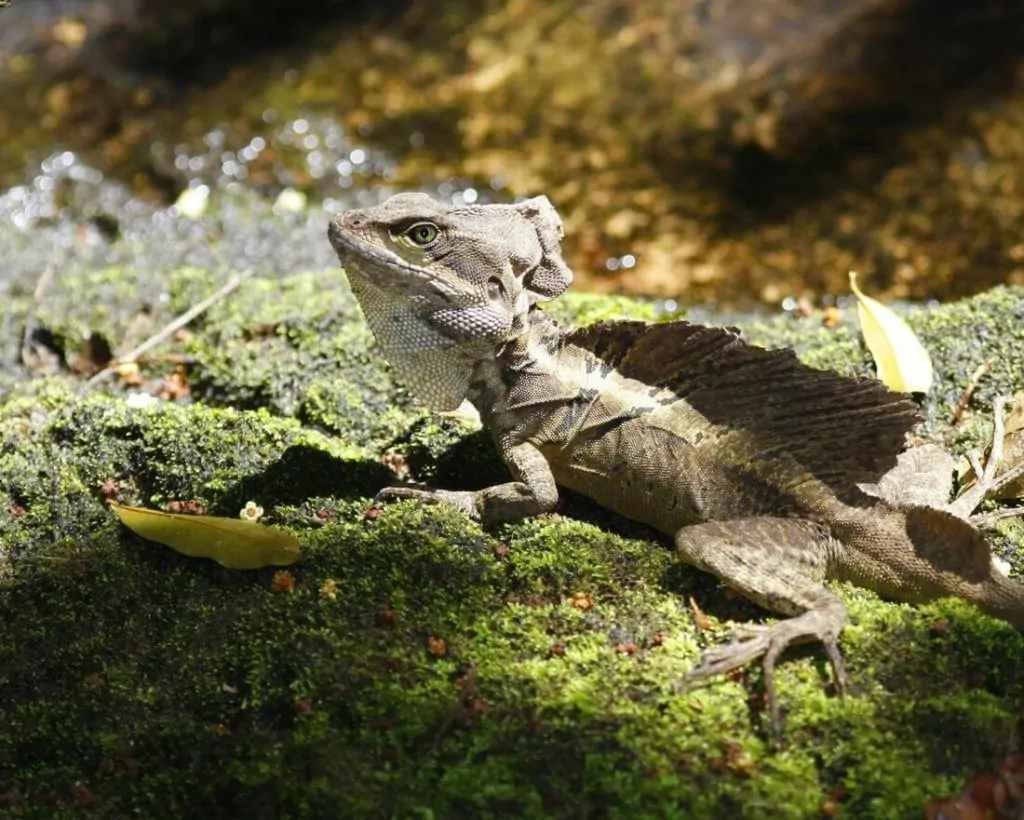
Start off with a layer of an absorbent substrate. We recommend using a coarse bark woodchip, as it’s low-maintenance and easy to clean.
If you want something more natural, you can go with a soil and moss mix. Just make sure it’s chemical-free!
Now, add hardwood decorations. Large climbing branches and grapevines are always appreciated. These lizards will take full advantage of any climbing surface!
Add a few tall and trailing plants as well. The plants should be able to provide some solace away from the light whenever the basilisk needs to cool down. You can also add artificial caves and covers.
Some large slate rocks, which retain heat, are good for those times when the lizard needs to warm up.
Expert Tip: If your brown basilisk is still young, add a lot of decorations! Juveniles can get a bit anxious when there’s too much open space in the enclosure. Several decorations will break up the open space a bit, and you can always remove items as your lizard grows.
Temperature & Lighting
Brown basilisks come from very warm jungles in Central America. You need to mimic those conditions as closely as possible.
Like most reptiles in the trade, brown basilisks will thermoregulate. As a result, the enclosure needs to have an adequate temperature gradient.
Here’s what you need to know:
- On the cool side, ambient temperatures should be around 75°F (which is around room temperature).
- On the opposite end of the enclosure, use a strong basking lamp to raise temperatures between 90°F and 95°F.
Brown basilisks can tolerate lower temperatures at night, but it’s good to create a warm area as well. Where you place your daytime basking spot, use a ceramic heat emitter at night. It should create a warm zone around 80 degrees even when the lights are off.
The final piece of lighting equipment you’ll need is a UVB lamp. These specialty lamps provide UV exposure, which is crucial for calcium synthesis. A 6-percent UVB lamp covering most of the enclosure is ideal.
Humidity
Humidity levels between 55 and 60 percent are a must if you want to keep your brown basilisk healthy. To achieve this, you can mist the enclosure every day. The absorbent substrate should hold onto the moisture to keep the air muggy enough.
Don’t rely on your instincts alone when it comes to maintaining the proper humidity! Invest in an accurate hygrometer to make sure that humidity levels are correct at all times. Checking this will become part of your daily routine.
Water
Brown basilisks need a water dish in their enclosures. But there’s a good chance that you’re not going to see them drink water out of it!
Nevertheless, it’s important to include it for good measure.
You might observe your lizard climbing into the dish to soak from time to time. Some may even defecate in it. Whatever the case may be, make sure that the dish is always full of clean water (dirty water can quickly lead to disease).
Food & Diet
Brown basilisks are omnivores in the wild. However, they tend to focus more on the meat side of their diet and rarely seek out fruits or vegetables.
Fresh greens and fruits are good, but their diets should consist of mainly insects!
Brown crickets are one of the better food options. You can also try black crickets or locusts. High-fat insects, such as mealworms, roaches, and grubs are good for the occasional treat.
You can feed these lizards small meals daily. Feed them as much as they can consume in one sitting. Also, make sure that none of the insects you provide are any bigger than the space between the lizard’s eyes!
Expert Tip: To ensure that your reptile is getting all the vitamins and nutrients they need, dust the food in powdered supplements. We recommend alternating between a calcium powder and a balanced multivitamin with D3.
Potential Health Issues
You don’t have to worry about any special diseases with the brown basilisk. They are no more at risk for health problems than any other reptile. However, they can still suffer from the usual health issues.
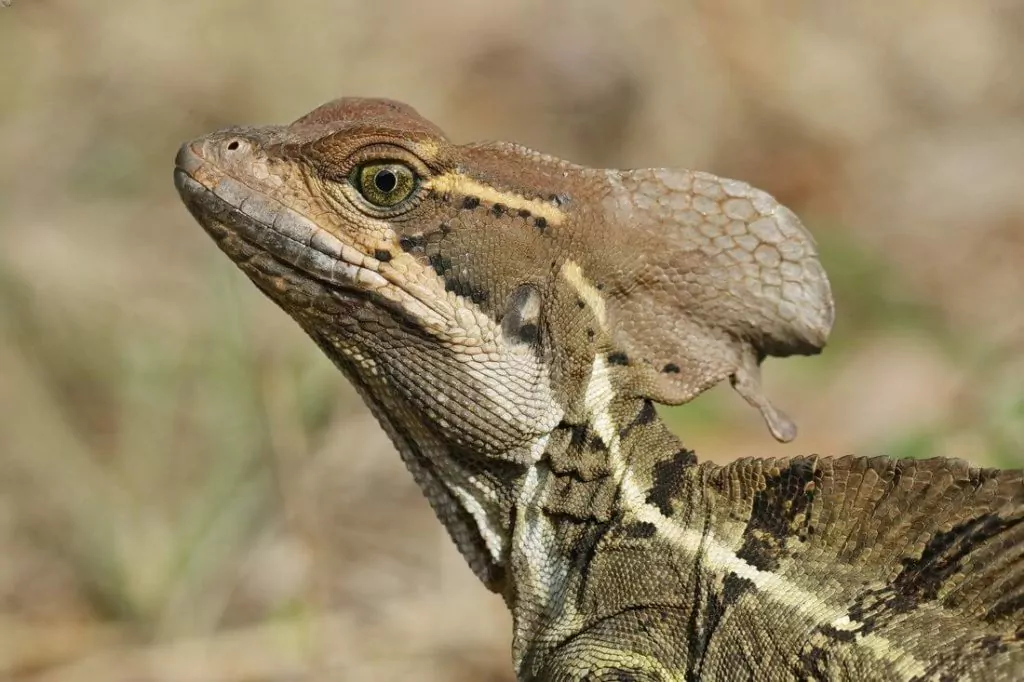
Some of the most common health conditions for captive reptiles are respiratory infections, bacterial infections, and metabolic bone disease.
Respiratory infections are usually a product of poor humidity levels. Temperature can play a part as well. Stay on top of enclosure conditions to lower your lizard’s risk of infection.
For bacterial infections, the culprit is usually a dirty vivarium! Bacteria can accumulate on every surface. You need to spot clean messes daily and disinfect the entire enclosure about once a month to avoid any bacterial problems.
Finally, there’s metabolic bone disease. This condition is a result of poor calcium synthesis. As we mentioned earlier, these lizards need UVB light. Without it, your basilisk can suffer from brittle bones that break at the drop of a hat! Deformities and other skeletal problems are possible, too.
Luckily, metabolic bone disease is avoidable, too. Just make sure that you replace the UVB bulb regularly and continue to provide calcium supplements.
Behavior & Temperament
Brown basilisks are not aggressive. In fact, they can be downright friendly once they get comfortable.
However, they can be flighty and anxious. This is especially true when you first bring them home.
It takes time for the basilisk to get used to their new surroundings. In the meantime, they may spend most of their time hiding or running away whenever you come around.
Once your basilisk gets more comfortable they should become quite calm. They’ll spend most of their day lounging around on climbable branches. You’ll see them moving to cooler spots under plants from time to time as well.
Expert Tip: Make sure that your enclosure has a tight lid! In the wild, brown basilisks will run on their hind legs to get away from trouble. They are fully capable of wriggling out of a poorly secured enclosure, so keep any doors or lids tightly secured.
Handling Tips
Brown basilisks are best observed on the other side of their glass enclosure. They don’t take to handling very well.
Many will do their best to wriggle free from your grasp. They may even scratch you with their toenails or whip you with their tail if they’re especially nervous.
No matter how comfortable these lizards get, they’re not going to like handling! Create a cozy habitat, watch them through the glass, and respect their space.
There are situations where you’ll have to handle them (like taking them to the vet or thorough enclosure cleaning). When this happens be as gentle as possible and limit the amount of time you spend handling them.
Conclusion
Proper brown basilisk care is all about being attentive and respecting the nature of these reptiles. If you provide them with a suitable environment and do your best to keep them comfortable, there’s a good chance that your pet will live a long and happy life.
If you have any questions that weren’t covered in this care sheet, send them over to us via the contact page on our site. We check these messages as often as we can, and always enjoy hearing from our readers!

